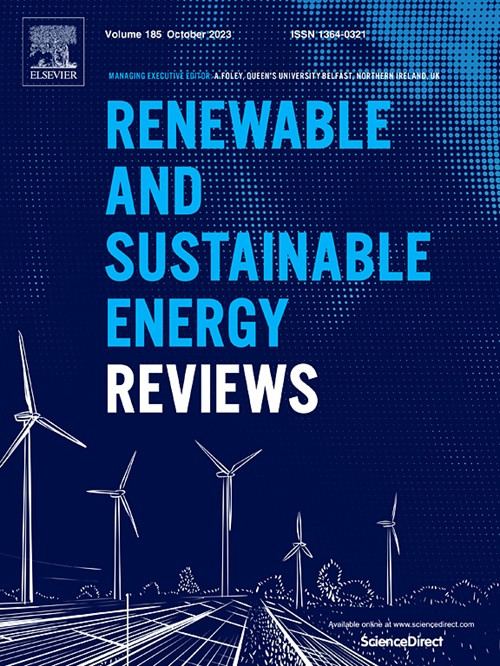电厂碳捕集技术评价的多准则决策分析
IF 16.3
1区 工程技术
Q1 ENERGY & FUELS
引用次数: 0
摘要
发电厂是二氧化碳排放的最大贡献者之一,这使得碳捕获和转化为有价值的产品成为应对气候变化和促进循环经济的关键战略。然而,选择最佳的二氧化碳捕获技术是复杂的,因为选择范围很广——如燃烧前、燃烧后和全氧燃料燃烧——以及涉及的各种技术、经济、环境和社会因素。本研究确定了三种电厂类型最有前途的二氧化碳捕集技术:天然气联合循环(NGCC)、褐煤和煤炭。本研究运用多准则决策分析(MCDA),将系统文献综述与层次分析法(AHP)和理想解相似性排序偏好法(TOPSIS)相结合,对现有技术进行排序。对于NGCC装置,燃烧后钙环法因其适度的CO2避免成本(€33.80/tCO2)、较高的效率(48.31%)和成熟的技术成熟度(TRL)为7而成为首选,相对紧密度得分为0.790。褐煤植物燃烧后化学吸收与MDEA的相对接近度最高,达到0.865,TRL为9。对于燃煤电厂来说,使用Selexol工艺结合mn基化学环法进行预燃烧最有希望,其相对接近度为0.829,二氧化碳避免成本低(19.94欧元/tCO2),净效率为37.13%。这些发现强调了在选择二氧化碳捕集技术时平衡经济绩效和技术成熟度的重要性。本文章由计算机程序翻译,如有差异,请以英文原文为准。

Multi-criteria decision analysis for evaluating carbon capture technologies in power plants
Power plants are among the largest contributors to CO emissions, making carbon capture and conversion into valuable products a key strategy to combat climate change and foster a circular economy. However, selecting the optimal CO capture technology is complex due to the wide range of options — such as pre-combustion, post-combustion, and oxy-fuel combustion — and the various technical, economic, environmental, and social factors involved. This study identifies the most promising CO capture technologies for three power plant types: Natural Gas Combined Cycle (NGCC), lignite, and coal. By applying Multi-Criteria Decision Analysis (MCDA), which integrates a systematic literature review with the Analytical Hierarchy Process (AHP) and Technique for Order Preference by Similarity to Ideal Solution (TOPSIS), the study ranks existing technologies. For NGCC plants, post-combustion calcium looping emerged as the top choice, with a relative closeness score of 0.790, due to its moderate CO avoidance cost (€33.80/tCO), high efficiency (48.31%), and mature Technology Readiness Level (TRL) of 7. In lignite plants, post-combustion chemical absorption with MDEA ranked highest, achieving a relative closeness of 0.865 and a TRL of 9. For coal plants, pre-combustion using the Selexol process combined with Mn-based chemical looping was most promising, with a relative closeness of 0.829, low CO avoidance cost (€19.94/tCO), and a net efficiency of 37.13%. These findings underscore the importance of balancing economic performance and technological maturity when selecting CO capture technologies.
求助全文
通过发布文献求助,成功后即可免费获取论文全文。
去求助
来源期刊

Renewable and Sustainable Energy Reviews
工程技术-能源与燃料
CiteScore
31.20
自引率
5.70%
发文量
1055
审稿时长
62 days
期刊介绍:
The mission of Renewable and Sustainable Energy Reviews is to disseminate the most compelling and pertinent critical insights in renewable and sustainable energy, fostering collaboration among the research community, private sector, and policy and decision makers. The journal aims to exchange challenges, solutions, innovative concepts, and technologies, contributing to sustainable development, the transition to a low-carbon future, and the attainment of emissions targets outlined by the United Nations Framework Convention on Climate Change.
Renewable and Sustainable Energy Reviews publishes a diverse range of content, including review papers, original research, case studies, and analyses of new technologies, all featuring a substantial review component such as critique, comparison, or analysis. Introducing a distinctive paper type, Expert Insights, the journal presents commissioned mini-reviews authored by field leaders, addressing topics of significant interest. Case studies undergo consideration only if they showcase the work's applicability to other regions or contribute valuable insights to the broader field of renewable and sustainable energy. Notably, a bibliographic or literature review lacking critical analysis is deemed unsuitable for publication.
 求助内容:
求助内容: 应助结果提醒方式:
应助结果提醒方式:


